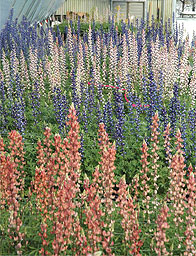Dallas, Texas
February 24, 2006
"This year's spring wildflower
season is shaping up to be pretty dismal," said Dr. Wayne
Mackay, a horticulturist with the
Texas Agricultural
Experiment Station in Dallas.
The state's prolonged drought means the dramatic displays of
color Texans are used to won't be as evident, Mackay said.
However, aficionados might still be able to enjoy the
wildflowers, he said. Bluebonnets are being grown commercially
for the cut-flower industry, and they aren't just blue any more.
Mackay, along with Experiment Station researchers Dr. Tim Davis
and Dr. Narendra Sankhla, have been developing long-stemmed
bluebonnets in a variety of colors since 1991. Working out the
problems inherent in the wildflower, which was necessary before
any new varieties could be released, took seven years. Those
problems included lengthening the flower, its life and its
ability to hold blooms, and increasing the bloom's density and
the flower's durability and greenhouse performance.
|
 |
|
A sea
of long stemmed bluebonnets exude an exotic, sweet scent
when grown under greenhouse conditions. This test plot
include, from front to back, a salmon-colored variety
named Texas Sunset, the traditional blue Texas Sapphire
and a light pink shade dubbed Texas Sunrise.
(Texas Cooperative Extension photo by Janet Gregg)
|
In 1998 the first two varieties of
long-stemmed bluebonnets – blue Texas Sapphire and white
Texas Ice were released.
"Florists like to have a series of colors in any given flower to
give them greater design capability," Mackay said. "We developed
a pink one and were working on a lavender shade to try to make
the overall crop more appealing. We just didn't quite have those
perfected at the time the first two were released. We've been
working on perfecting them ever since."
In 2001 Mackay and his team traveled to the Big Bend in West
Texas in search of new genes to cross into the pink bluebonnet
line. Despite the Hill Country's fame for spring wildflowers,
Mackay said, the show in West Texas and especially the Big Bend
is even better.
"Bluebonnets grow best under high light and low humidity
conditions," Mackay said. "The Big Bend area puts on a really
spectacular show and the ‘wow!' factor is even greater because
you're out in the middle of a desert."
The 2001 wildflower season was especially good, he said "When we
went and surveyed the population, I found about nine plants in
the wild that were pink flowered," Mackay said. "There were so
many flowers out there that year, the bees were simply
overwhelmed and they weren't visiting the pink ones at all.
"So we drove 90 miles to the nearest store and bought water and
kids' paint sets, and drove back and hand-pollinated all of the
pink bluebonnets we could find in about a 50-mile area. We
watered them and discretely marked them so we could find them
again, and then we left. Four weeks later we went back and
collected seeds from all of those plants. And you know, the only
pink bluebonnet seeds we found were from the plants we had
hand-pollinated. If we hadn't done it, there wouldn't have been
any seeds for us to collect. So it was worth all of the effort."
In 2002 the seeds were grown and the best crossed back into the
pink breeding lines. The researchers saw a difference
immediately, Mackay said.
The plants flowered earlier, were sturdier for greenhouse
production and had good longevity, he said.
During the past four years the team has been fine-tuning the
plant's development for color, number of flowers on the stem,
stem length and greenhouse performance.
Much of that greenhouse performance involved developing a
resistance to ethylene, a naturally produced gas that can also
be man-made. Wild bluebonnets exposed to ethylene lose their
blossoms. Because plants produce ethylene naturally, this was a
problem in confined areas, such as greenhouses. The team has
developed bluebonnets that are resistant to ethylene, giving the
flowers a longer base life.
"We know we could continue to improve them forever, but we feel
we have finally reached the point where we have met the critical
needs," Mackay said. "We'll be ready to release the pinks for
commercial production within the next year and a half."
Pink bluebonnets don't exist anywhere else, he said. The team
has isolated four shades of pink. The two most likely to be
released first are a light pink named Texas Sunrise and
dark pink that hasn't been named yet.
The team also is working on a salmon pink dubbed Texas Sunset
and another shade of pink Mackay calls a true pink, which also
hasn't been named yet.
The bluebonnet's potential color palette is limited, Mackay
said.
"If the base pigments aren't found in the wild, the only way to
create other colors out of the blue, white and pink color
palette range, would be to cross the bluebonnets with other
lupine species," he said.
He admits that is a long-term possibility, but said for now he
will continue to work on the shades that have yet to be
released.
"Our goal is to produce these as a crop aimed at being a larger,
worldwide commodity," Mackay said. "We started this project
because there was a lack of blue-flowered plants available to
the cut-flower industry, which means there was a niche market
that needed to be filled.
"We're well on the road to accomplishing that and a whole lot
more."
Writer:
Janet Gregg |